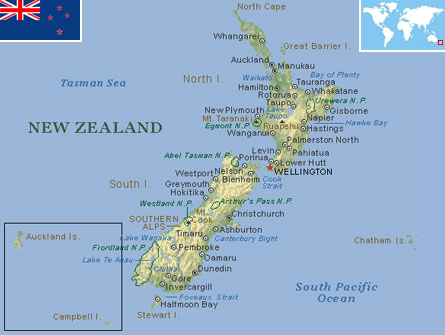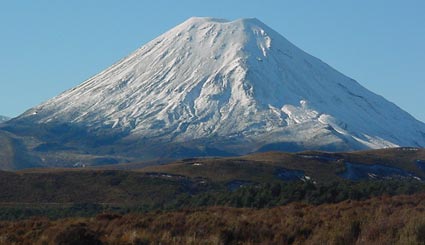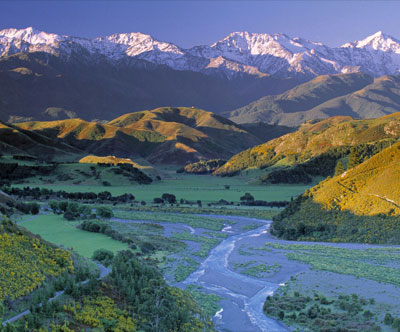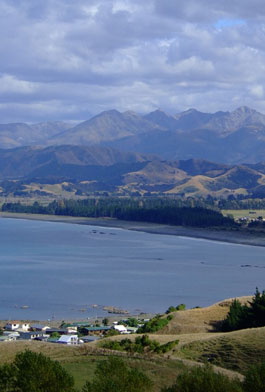New Zealand
Country statistics

Land area: 103,483 sq miles (268,021 sq km)
Total area: 103,738 sq miles (268,680 sq km)
Population (2010 est.): 4,252,277 (growth rate: 0.9%); birth rate: 13.8/1000; infant mortality rate: 4.8/1000; life expectancy: 80.5; density per sq km: 15
Capital City: Wellington
Monetary unit: New Zealand dollar
Languages: English, Maori (both official)
Ethnicity/race: New Zealand European 74.5%, Maori 9.7%, other European 4.6%, Pacific Islander 3.8%, Asian and others 7.4%
Religions: Anglican 24%, Presbyterian 18%, Roman Catholic 15%, Methodist 5%, Baptist 2%, other Protestant 3%, unspecified or none 33% (1986)
Country introduction

New Zealand is an island country located in the South-western Pacific Ocean. It comprises of two main islands (called the North and South Islands in English, Te-Ika-a-Maui and Te Wai Pounamu in Maori) and a number of smaller islands. The tallest North Island mountain, Mount Ruapehu (2,796 m / 9,176 ft), is an active cone volcano. The South Island is the largest land mass, and is divided along its length by the Southern Alps, the highest peak of which is Aoraki/Mount Cook.
The dramatic and varied landscape of New Zealand has made it a popular location for the production of television programmes and films, including the Lord of the Rings trilogy.
Because of its long isolation from the rest of the world and its island biogeography, New Zealand has extraordinary flora and fauna. About 80% of the New Zealand flora occurs only in New Zealand, including more than 40 endemic genera. The main two types of forest have been dominated by podocarps including the giant kauri and southern beech. The remaining vegetation types in New Zealand are grasslands of tussock and other grasses, usually in sub-alpine areas, and the low shrublands between grasslands and forests.
The culture

New Zealand has a diverse contemporary culture with influences from British, Irish, and Maori cultures, along with those of other European cultures and - more recently - Polynesian (including Samoan, Tongan, Niuean, Cook Islands Maori, Tahitian, and Hawai'ian) and Southern and South-east Asian (Indian, Chinese, Korean, Cambodian, and Japanese) cultures.
New Zealand's landscape has appeared in a number of television programmes and films. In particular, the television series Hercules: The Legendary Journeys and Xena: Warrior Princess were filmed around Auckland, and the film Heavenly Creatures in Christchurch. The television series The Tribe is set and filmed in New Zealand. New Zealand director Peter Jackson shot the epic The Lord of the Rings film trilogy in various locations around the country, taking advantage of the spectacular and relatively unspoiled landscapes, and Mount Taranaki was used as a stand-in for Mount Fuji in The Last Samurai. The latest of such major international films to be released are King Kong, The Chronicles of Narnia: The Lion, the Witch and the Wardrobe.
Attractions & landmarks

New Zealand is a small country of immense beauty with many attractions to see.
Located in the South Pacific Ocean, New Zealand is made up of two main islands, the North and South.
The North Island is home to the majority of New Zealand's four million people. It is known for its beaches, islands, volcanoes and geothermal areas, and for showcasing the Maori heritage. The island offers areas of scenic beauty such as that seen in the Bay of Islands, which has over 200 islands within the greater area.
The North Island's major cities, Auckland, New Zealand's largest city with a third of the country's population and Wellington, are exciting hubs of culture, cuisine and nightlife.
Rotorua is probably the smelliest city in New Zealand. Built on a geothermal region Rotorua has several natural attractions in the form of mud holes, geysers and hot pools. The huge capacity of the geothermal resource is large enough to allow the generation of electricity for New Zealand's main grid.
Lake Taupo is New Zealand's largest lake and is the result of one of New Zealand's historical volcanic eruptions. Now teeming with large trout and eels and surrounded by gorgeous native bush, Lake Taupo is an essential stop for a stay while passing through the North Island.
In contrast the South Island is famous for its dramatic landscapes and wildlife.
Christchurch, the largest city in the South Island, is often referred to as a more English city than those in England in the United Kingdom. Situated at the base of an extinct volcano that formed Banks Peninsula, Christchurch looks out over the Canterbury Plains towards the majestic Southern Alps. During the early exploration of the Antarctic, Christchurch was often used as the departure point for expeditions and today is used by many nations to support their Antarctic bases.
Some of the world's finest alpine walking is found in the South Island. It is a region of untamed beauty with alpine meadows that extend to the glaciers and snowfields beneath the picture perfect summits of Mt Cook, Mt Aspiring and other peaks that form the Southern Alps. It stretches almost the entire length of the island.
The incredible 'sunken mountains' of Fiordland and the Marlborough Sounds are easily explored by boat, while Kaikoura is the destination for whale watching and swimming with the dolphins and sharks. The steep sided mountains along Kaikoura's coast continues down from the water's edge to depths of around 2 km (1.2 miles). These impressive depths attract sperm whales and elusive giant squids from other parts of the world.
Further down south untamed island of Rakiura will be found (aka Stewart Island), which is a true haven of native wildlife.